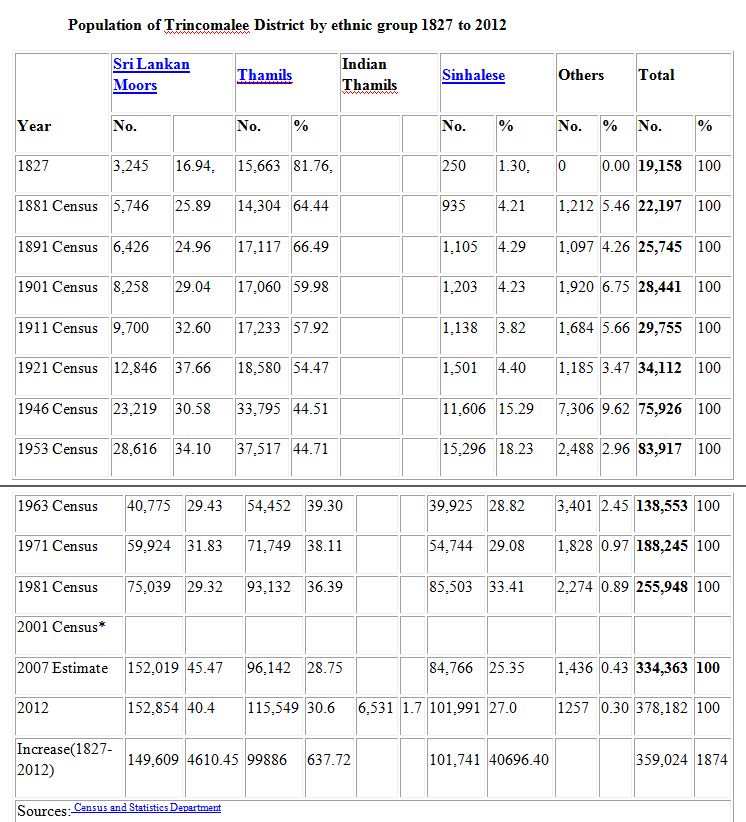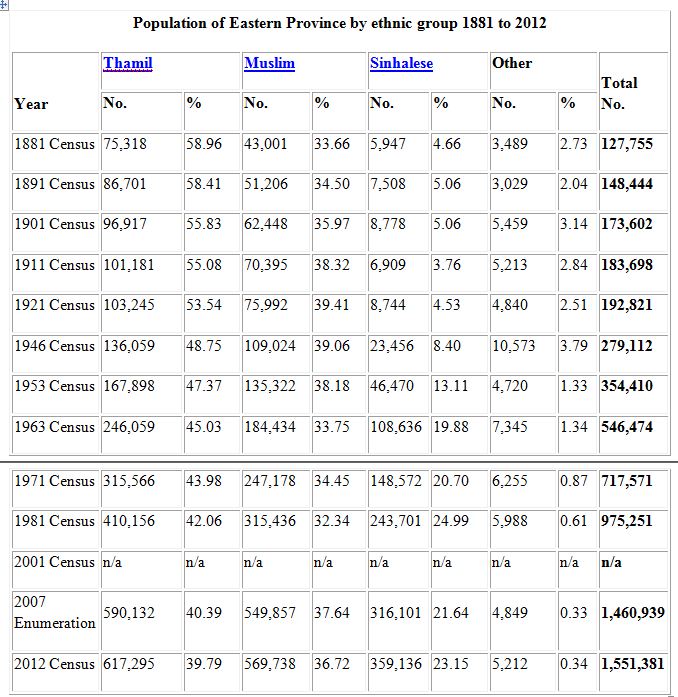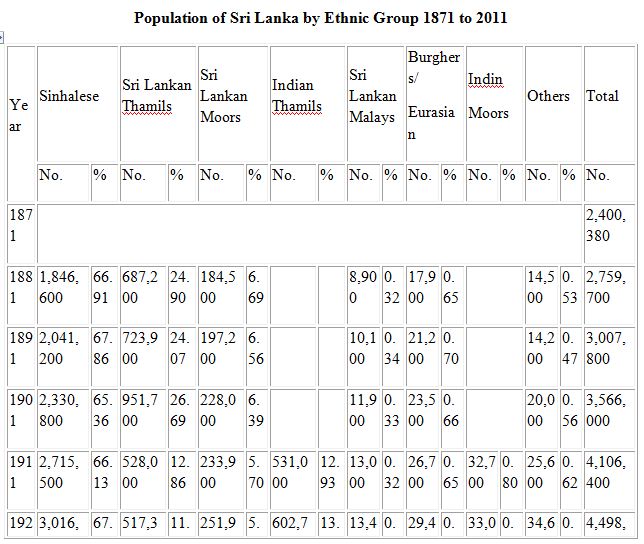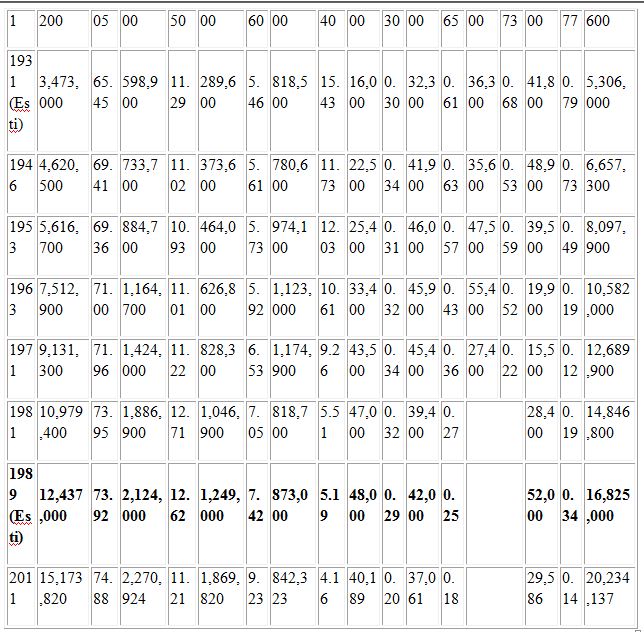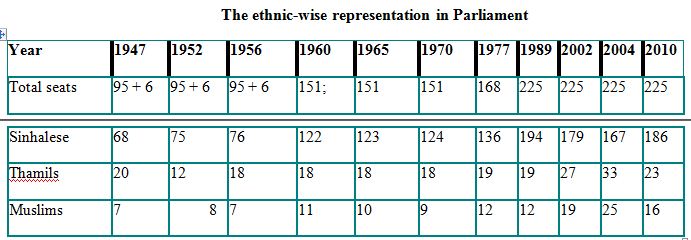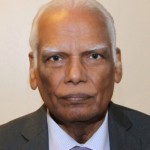
President Mahinda Rajapaksa is holding Sri Lanka’s 65th independence anniversary celebration with pomp and gaiety in Trincomalee this year. The choice of Trincomalee, a once predominantly Thamil dominated district as the venue should not be lost in the cry for justice.
Veluppillai Thangavelu
At the time of independence in 1948 the Thamils constituted 44.51 (33,795) of the population in Trincomalee as compared to Muslims 30.58 (23,219) and Sinhalese 15.29 (11,606) but today the demography has been drastically altered. The Thamils now (2012) constitute only 30.6 (115,549) Muslims 40.4 (152,854) and Sinhalese 27.0 (101,991). There is no need to explain why the Thamil population declined so dramatically. In 1827 the Thamils constituted 81.80 (15,663) of the population, the Muslims only 16.90 (3,245) and Sinhalese a mere 1.3 (250). The Muslims between 1981 and 2012 have more than doubled their numbers from 75,039 to 152,854 (11.08) as seen in the following Table 1:
*2001 Census was only carried out partially in Trincomalee district
Independence for the Thamils have meant slow liquidation of their identity as a Nation that lived in well defined territory with their own language, arts, culture, customs and heritage. They have been living in the Northeast historically for several centuries.
On February 4, 1948 2 million Thamils of Ceylon exchanged their white masters (British) for the brown sahibs the Sinhalese. It was like jumping from the frying pan into the fire.
Sri Lanka, then Ceylon, would not have gained independence from Britain without the support and consent of the Thamil people. That was exactly what happened on that fateful day! Thamil legislators trustingD.S.Senanayake almost voted with their feet giving a 4/5 majority for the constitutional recommendations. These constitutional recommendations were largely those of the 1944 Board of Ministers’ draft, a document reflecting the influence of D.S. Senanayake behind the scene and his main advisor, Sir Ivor Jennings. It ushered in Dominion status and Independence to Sri Lanka then Ceylon in 1948.
On the eve of the arrival of Soulbury Commissioners, D.S.Senanayake master-minded the appointment ofArunachalam Mahadeva to the Pan Sinhala Board of Ministers as the Minister of Home Affairs to project a “Ceylonese” vision for Sri Lanka, i.e., co-operation of all the ethnic and minority religious groups. It was a diplomatic coup by Senanayake and the Commissioners fell for the ruse ignoring past history.
The Thamil Congress, led by Ponnambalam, argued for 50-50 representation, an artificial concept doomed to failure in the face of “one man-one vote” concept thoroughly accepted in European liberalism. However, theKandyan Sinhalese were more pragmatic and wiser. They proposed a Federal scheme where the Up-country region, the Low-country, and the North would be three federal states. Their suggestions were rejected by the commissioners who found no merit in the federal proposals.
In fact, it was the Thamil leaders like Sir Ponnambalam Ramanathan (1851-1930) and Sir Ponnambalam Arunachalam (1853-1924) who fearlessly spearheaded the struggle for constitutional reforms that led to independence from colonial yoke.
However, the Ponnambalam brothers in their evening of life realised that the Sinhalese politicians have let them down the garden path and taken them for a ride to advance the interests of the majority community at the expense of the Thamil people. Sir Ponnambalam Ramanathan foresaw that the democratic principle of one-person one vote in a heterogeneous society would ultimately lead to tyranny of the majority.
In a speech to the Legislative Council during the debate on the Donoughmore Reforms, Mr. Ramanathan appears the precursor of the Thamils demand for a sovereign state of Thamil Eelam.
“Why did the (Donoughmore) Commissioners not study Ireland, which is next door to them? They (Irish) said that we are one lot and you are another. We cannot work together. We must have separate governments. Then I ask what happened in the Dominion of Canada? The officials concerned said, it is an impossible situation…. Let us give these French descendants one form of government and let us give the other people another form of government – forms of government suitable to the interests of each of these great big communities. Why did the Commissioners think of that?”
It was Sir Arunachalam Ponnambalam who first (1923) exhorted the Thamils that –
“they should work towards promoting the union and solidarity of what we have been proud to call THAMIL EELAM. We desire to preserve our individuality as a people, to make ourselves worthy of inheritance. We are not enamoured about the cosmopolitanism which would make us neither fish, fowl nor red-herring.”
D.S.Senanayake, the first Prime Minister of independent Ceylon, gave the following solemn promise to the Thamil and other minority communities “no harm need you (non-Sinhalese) fear at our hands (Sinhalese) in a free Lanka.” He was speaking in the State Council in October 1945 when all the Thamil members had unanimously voted for the acceptance of the Soulbury constitution in a White Paper.
“Do you want to be governed from London or do you want, as Ceylon, to help govern Ceylon? On behalf of the (Ceylon National) Congress (founded by Sir Ponnambalam Arunachalam in 1919) and on my behalf, I give the minority communities the sincere assurance that no harm need you fear at our hands in a free Lanka.”
But in 1948, the very year of Independence, D.S.Senanayake blatantly went back on the promise and bared his true colours as an unrepentant champion of Sinhala chauvinism by depriving one million Thamils of their citizenship.
The Citizenship Act No.18 was unique in that it denied citizenship to a person born in the country before or after 1948 unless, at least, his father was born in or was a citizen of Sri Lanka. The following year, the same Thamils were deprived of their franchise rights by a simple amendment to the Parliamentary Elections Ordinance that stated only citizens have the right to vote in elections. This reduced Thamils representation in Parliament from 33 in 1948 to a mere 20 in 1952.
The Citizenship Act No. 18 of 1948 opened the floodgates to further legislative and administrative acts, which robbed Thamils of their language, educational, and employment rights.
It might be informative at this stage to recapitulate the history of the National conflict between the Thamil Nation and the Sinhala Nation.
National Conflict Between the Thamil Nation and the Sinhala Nation
The Thamils and the Sinhalese are divided on the basis of territory, language, religion, and culture. The enmity between the Thamils and the Sinhalese go back to at least two centuries before Christ.
The Mahavamsa, a Buddhist chronicle written in the 6th century AD by a Buddhist monk portrays the Naga King Dutugemunu as the National Hero who defeated the Thamil King Ellalan and unified the whole of Ceylon. Though Buddhism infinitely values human life as being the one and only condition from which nibbana (salvation) could be attained, Mahavamsa made a virtue of killing in defence of Buddhism. This 5th century AD chronicle has been used to raise the cry of Race, Land and Faith by the Sinhalese-Buddhist chauvinistic forces during the past years.
The Mahavamsa has perpetrated the myth that Sinhalese-Buddhists are a chosen people with the special mission of preserving the Buddhist religion in Sri Lanka. Dr.Walpola Rahula, a scholar monk, wrote “for more than two millennia the Sinhalese have been inspired that they were a nation brought into being for the definite purpose of carrying the torch lit by Buddha.”
In Mahavamsa tradition the Thamils are considered unbelievers, villains and invaders. It is the Mahavamsa theory that the Island as a whole belongs to the Sinhalese Buddhists only, and that there is no place or only second class status for Thamils. This Mahavamsa tradition is the root cause of the present conflict between the Thamil Nation and the Sinhala Nation.
Those who wish to see an end to the national question would have to take into consideration the Mahavamsa mind-set. For it is the Mahavamsa mode of thinking which has influenced all the rulers, especially the governments of post independence Ceylon.
Broken Promises and Pacts
The planned state-aided colonization of Thamil traditional Homelands, the Sinhala Only Act, the recognition of Buddhism as the state religion, the lion flag as the national flag, the national anthem and the stubborn insistence on a unitary constitution are manifestations of the Mahavamsa mind-set deeply embedded in the Sinhalese psyche. Initiatives in the past to settle the national question by the signing of the Bandaranaike -Chelvanayakam pact (1957), Dudley Senanayake– Chelvanayakam pact (1965), and the Indo-Ceylon Accord (1987) failed because of this single factor.
Colonization
Through systematic state-aided Sinhalese colonisation of the traditional homelands of the Thamils, the demographic profile of the Thamils has been drastically altered. In the Eastern Province, the once majority Thamil community (53.54 in 1921) has been reduced to a minority 39.79 in 2012 (42.06 in 1981) whereas the percentage of Sinhalese rose from 4.53 in 1921 to a staggering 23.15 in 2012 (24.99 in 1981).
TABLE 2
Island wide the Thamil population also declined steeply from 26.69 in 1901 to 15.37 in 2012 as shown by the following Table 3:
In 1946 the Thamils (both Ceylon and Thamils of Indian origin) constituted 22.75 (1,514,300) and Sinhalese 69.41 (4,620,500), but in 2011 the Thamil population declined to 15.37 (3,113,247) while the Sinhalese population rose to 74.88 (15,173,820). This decline is reflected in the dilution of their parliamentary representation as the following Table 4 shows:
The repatriation of 525,000 Thamils of Indian origin in the seventies reduced their population from 1,174,900 in 1971 to 818,700 in 1981.
Sinhala Army of Occupation
There are more than 265 Sri Lankan army, naval and air force camps (about 90 of total camps in Sri Lanka) scattered throughout the North and East. In the North alone there are army camps in 153 Grama Niladhari Divisions. Out of a total of 20 Divisions 17 are stationed in the North (15) and East (2) consisting of more than 150,000 soldiers. Along A9 highway there are over 30 army camps. The heartland of Vanni is dotted with army cantonments, army camps, naval and air force bases. The army has taken to cultivation on lands previously owned by the Thamil people in a big way.
West of the Iranamadu Tank and East of the A-9 highway 25 acres of land are being cultivated by the army with vegetables; in Theravil, almost 150 acres of land are being cultivated by the army with fruit trees, in Vellamkulam, about 600 acres of land are being cultivated by the army with cadjunuts, in Mukkombu 100 acres of land are being cultivated by the army with coconuts; in Chunnavil, 600 acres of lands are being cultivated by the army with cadjunuts. These are all in Vanni. A large extent of paddy fields under village tanks are being cultivated by the army. The army is engaging in all these activities in lands previously owned by Thamils. These areas are out of bounds for civilians.
In Murugandy a mega housing scheme consisting of 10,000 houses covering 12,000 acres of fertile land previously owned by Thamil peasants is ready for occupation by army personnel. The housing scheme built by Chinese is complete with all infra-structural facilities like roads, schools, hospitals, water, electricity etc. The displaced Thamils have been asked to fend for themselves in welfare centres.
In the Jaffna peninsula a total of 716 private properties are under occupation by the army. Out of these, 378 lands are with houses, 283 are plain lands and 46 lands are business buildings. The SLA has also seized 9 public lands for its use outside the HSZ. Further 253 lands are under the control of the Sri Lanka Navy, 123 of these are with houses, 104 plain lands, 7 lands with commercial buildings and 19 public lands. 64 lands are under the control of the Sri Lanka Police, 57 of these lands are with houses, 5 plain lands and at least one with a commercial building. Now, the SL military is seeking to legalise the seizure to enable itself to establish permanent cantonments in Jaffna.
2013 Budget The 2013 budget envisages a 13.5 percent increase in spending from 2.22 trillion rupees to 2.52 trillion rupees (US$19.5 billion). Total Projected Income for year 2013 Rs. 1,280.00 Billion resulting in a Budget Deficit of Rs. 1,240.00 Billion. In 2012 the budget deficit was Rs 468 billion.
Like in the past years a major chunk of the budget is allocated for the Defence and Urban Development Ministry with 289.5 billion rupees. The amount is an increase of nearly Rs. 60 billion from last year’s allocations of 229.9 billion rupees, an increase of 26. The Ministry of Rehabilitation and Prison Reforms has been allocated a pittance of Rs.500 million!
The total maximum borrowing for 2013 has been increased by 12.6 percent from 2012 to 1.3 trillion. The debt repayment expenditure in 2013 will rise to 1,154 billion rupees ($US9.1 billion) from 914 billion rupees in 2012, a 26 percent increase. Total outstanding loans were 6,262 billion rupees, a 23 percent increase over the previous year. Of that total, external foreign currency loans accounted for 2,981 billion rupees, up by nearly 33 .
Sri Lanka is maintaining the largest army in the world on a per capita basis. Sri Lanka’s population of 21 million has a standing army of 500,000. Ninety-five percent of the army consists of Sinhalese. This means that there is a soldier for every 42 persons in the population. India has an army of 1.13 million and a population of 1020 million, which means a ratio of one soldier to 916 people. On the Sri Lankan ratio India has to have a standing army of 10.2 million.
There are 144 government MPs in Parliament out whom 68 are Ministers and 28 are Deputy Ministers. It cost around Rs. 400 million per Minister per month (about 3 million US dollars). The government also proposes to appoint 25 District Ministers. That will escalate the number of Ministers to 121 leaving only 23 ordinary MPs. The tragedy is Mahinda Rajapaksa gets away with jumbo cabinet, corruption, nepotism and authoritinism without much ado.
Human Rights Violations
In its Word Report the Human Rights Watch slammed the Sri Lankan government claiming ” Sri Lanka continued its assault on civil society and failed to take meaningful steps towards accountability for war crimes during the country’s armed conflict that ended in 2009.
There was no fundamental progress on key human rights issues in Sri Lanka over the past year, Human Rights Watch said. Overly broad detention powers remained in place under various laws and regulations, leaving several thousand people detained without charge. State security forces committed arbitrary arrests and torture, including sexual assault, against ethnic minority Thamils. Repatriated Thamils allegedly linked to the defeated Liberation Tigers of Thamil Eelam (LTTE) were at particular risk, Human Rights Watch research found. While the Thamil population in the north benefitted from greater access by humanitarian groups, the military presence kept living conditions from being normalized.
“The Sri Lankan government needs to address the many problems that undermine basic rights for people in the war-torn North and East,” said Brad Adams, Asia director at Human Rights Watch. “Justice and accountability for abuses, an end to torture in detention, and ending constraints on basic liberties continue to prove elusive for the Thamil population.”
The UN Human Rights Council, responding to the government’s prolonged failure to investigate alleged laws of war violations, adopted a resolution in March 2012 calling on Sri Lanka to take all necessary steps to ensure justice and accountability.
“UN member states have made it clear through the Human Rights Council resolution in March and theUniversal Periodic Review hearings in November that Sri Lanka needs to make fast and meaningful progress on its rights commitments,” Adams said. “The Sri Lankan government should recognize that its past stalling tactics have run their course and that it will need to take real action.”
President Mahinda Rajapaksa and his siblings continued the trend of recent years to accumulate power at the expense of democratic institutions, including the judiciary, and constrict free speech and association. The government targeted civil society through threats and surveillance. Statements by government officials and government-controlled media named and threatened human rights defenders who called for accountability for wartime abuses or criticized other government policies.
“There is ample evidence that Sri Lanka’s current government acts to serve its own interests at great cost to democratic institutions and equal treatment of all communities,” said Adams.
“When a government fails to protect the rights of its citizens, the need for international action increases,” Adams said. “The international community in 2012 focused renewed attention on Sri Lanka, and given the lack of progress on accountability and the shrinking political space, should continue to do so.”
But for Mahinda Rajapaksa it is business as usual. He has sacked the Chief Justice Dr.Shirani Bandaranayke with minimum fall out. The unprecedented constitutional crisis elicited only a yawn. It has not made any dent on the popularity of the government. Mahinda Rajapaksa continues to ride on the wave of Sinhala nationalism. The black coated fraternity which threatened not to recognize any new Chief Justice has now fallen in line.
The government unlike last time, is taking things easy about the forthcoming 22 nd sessions of the UNHRC in Geneva in March, 2013. No Ministers will take wings to Geneva only diplomats will attend. Foreign MinisterG.L. Peiris says Sri Lanka will lobby enough votes to defeat US resolution. He is confident that unlike last time India will support Sri Lanka.
There is no progress in the implementation of the LLRC recommendations. The Army says it will not withdraw from North and East. In fact the army is building more bases and refusing to dismantle the HSZs it is occupying. The Thamils IDPs in their thousands continue to languish in camps and welfare centres. In short militarization, Sinhalization and Budhistization of the North and East continue merrily.
Not withstanding the fact that the Thamils are in the political doldrums, economic stagnation and social strangulation since independence, we should not lose heart but fight back peacefully to regain our lost freedom and dignity. It may not be within our power, may not be in our time, but if we choose to stand firm, unrelenting and continue to resist we shall prevail one day.
*Veluppillai Thangavelu is a Tamil Canadian of Thamil Eelam origin. His native village is Colombothurai in the outskirts of Jaffna Municipality. He was born on February 10, 1933 in a modest farming family.
He joined the Government Clerical Service in 1952. Later he joined the Local Government Service as an Accountant and served in Jaffna Municipal Council (1966-1972) Batticaloa Municipal Council (1972-1973) Dehiwela Mt. Lavania Municipal Council (1973-1977) and Colombo Municipal Council (1977-1980). He was also acting Municipal Commissioner (1967-1968) of Jaffna Municipality. In 1980 he joined the Bauchi State (Nigeria) Audit department as Principal Auditor. In 1987 he resigned his post and migrated to Canada and joined A. A. Jamal Associates, Chartered Accountants, Markham as an Auditor. He retired in 1995.
He is the author of Sothidap Puraddu(Astrology is Fraud) which was released in Thamil Nadu in 2006 by Periyaar Dravidar Kazhakam and in Canada in 1997. This book (700 pages) in Thamil is the first to comprehensively debunk astrology as a pseudo science with facts and figures.
Thangavelu is the President of Thamil Creative Writers Association (TCWA) founded in 2002.
